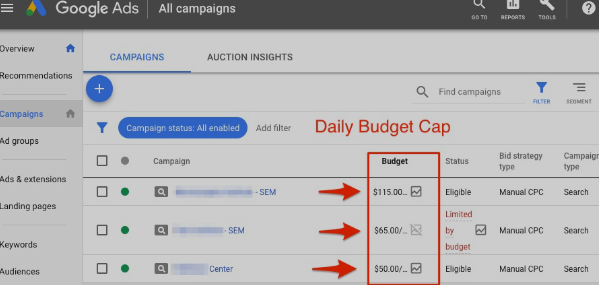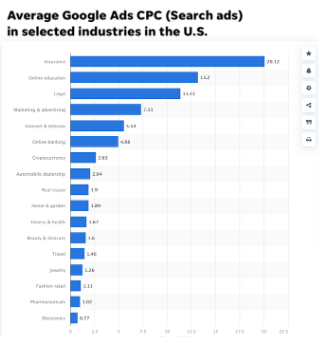Are you curious about the Google Advertising Costs? Wondering how much it will set you back to run ads on the world’s most popular search engine? Well, you’re in the right place! In this article, we’ll delve into the nitty-gritty details of Google advertising costs and provide you with a clear understanding of what to expect.

When it comes to Google Advertising Costs, the cost is primarily determined by two factors: your budget and the competitiveness of your chosen keywords. Google Ads operates on a pay-per-click (PPC) model, meaning you only pay when someone clicks on your ad. The amount you’re willing to spend per click, known as your maximum cost-per-click (Max CPC), plays a crucial role in determining your ad’s position and visibility.
Now, let’s talk about budgets. Google Ads allows you to set a daily budget, which is the maximum amount you’re willing to spend on your campaigns each day. The key here is finding the sweet spot between budget and desired results. You don’t want to overspend or underspend—balancing your budget enables you to reach your target audience effectively.
The competitiveness of your chosen keywords also affects the cost of your Google advertising. Keywords that are highly sought after by advertisers tend to have higher costs. This means that if you’re targeting competitive keywords, you might need to allocate a larger portion of your budget to ensure your ads are displayed prominently.
Additionally, the quality and relevance of your ads and landing pages can influence your costs. Google rewards advertisers who create high-quality, relevant ads by reducing their cost-per-click. So, it’s essential to craft compelling and engaging ad copy that resonates with your target audience.
To make the most of your advertising budget, it’s advisable to continually monitor and optimize your campaigns. Analyze the performance of your ads, adjust your bids and budgets accordingly, and refine your targeting to maximize your return on investment (ROI).
Google Advertising Costs are influenced by factors such as your budget, the competitiveness of keywords, and the quality of your ads. By carefully managing these aspects and regularly optimizing your campaigns, you can achieve a cost-effective and successful Google advertising strategy that drives relevant traffic to your website.
Google Advertising Costs: A Deep Dive into Pricing Strategies and Industry Trends
Google Advertising Costs : Are you a business owner looking to expand your online presence? If so, you’ve probably considered advertising on Google. Google advertising is a powerful tool that allows businesses to reach their target audience effectively. However, before diving into this advertising platform, it’s crucial to understand the costs associated with it. In this article, we’ll explore the pricing strategies and industry trends surrounding Google advertising costs.

When it comes to Google advertising, there are several pricing options available. One common method is the cost-per-click (CPC) model, where advertisers pay every time someone clicks on their ads. This approach ensures that businesses only pay for actual engagement and can set their desired maximum CPC bid. Another option is the cost-per-thousand-impressions (CPM) model, which charges based on the number of impressions an ad receives. This strategy is particularly useful for brand awareness campaigns.
The cost of Google advertising varies depending on factors such as keyword competitiveness, industry, targeting options, and the quality of your ad copy. Highly competitive industries and popular keywords often have higher costs per click. However, by carefully selecting relevant keywords and optimizing your campaigns, you can maximize your return on investment (ROI).
Industry trends also play a significant role in Google advertising costs. As more businesses turn to digital marketing, competition increases, leading to higher costs. Additionally, specific events or seasonal trends can impact pricing—for example, holiday seasons often see a surge in advertising costs due to increased competition.
To make the most of your advertising budget, it’s essential to constantly monitor and optimize your campaigns. Regularly reviewing your keywords, ad copy, and targeting options can help you identify areas for improvement and refine your strategies accordingly. Additionally, leveraging Google’s advanced targeting capabilities, such as demographics and interests, can help you reach your desired audience more effectively.
Understanding Google advertising costs is vital for any business aiming to succeed in the digital landscape. By employing the right pricing strategies and staying informed about industry trends, you can make informed decisions that maximize your advertising budget’s impact. So, take the plunge into Google advertising and unlock the potential to reach your target audience effectively.
Unlocking Success: How Smart Businesses Optimize Google Advertising Costs for Maximum ROI
Are you a smart business owner looking to unlock success and maximize your return on investment (ROI) through Google advertising? You’re in the right place! In this article, we’ll dive into the world of optimizing Google advertising costs to help your business thrive.
Google advertising, also known as Google Ads or Google AdWords, is a powerful tool that allows businesses to display ads on Google’s search engine results pages. It offers immense potential for reaching a vast audience and driving valuable traffic to your website. However, without proper optimization, your advertising costs can quickly skyrocket, leading to wasted resources and minimal returns.
So, how can smart businesses optimize their Google advertising costs for maximum ROI? Let’s explore some strategies:
Keyword Research: One of the fundamental pillars of successful Google advertising is conducting thorough keyword research. By identifying the keywords that are most relevant to your business, you can target your ads more effectively, ensuring they appear to users actively searching for your products or services. This targeted approach minimizes wasted ad spend and drives higher-quality traffic to your website.
Quality Score Improvement: Google assigns a Quality Score to each keyword and ad combination, based on factors such as ad relevance, landing page experience, and click-through rate. Improving your Quality Score can significantly impact your ad costs. By creating compelling ads, optimizing landing pages, and improving the overall user experience, you can increase your Quality Score and reduce your cost per click.
Ad Scheduling: Smart businesses understand the importance of timing. By analyzing data and understanding when your target audience is most active and engaged, you can schedule your ads to run during peak times. This ensures that your budget is allocated towards the periods when your ads are more likely to generate clicks and conversions, maximizing your ROI.
Ad Copy Optimization: Crafting compelling and engaging ad copy is vital to stand out from the competition and entice users to click on your ads. Use powerful language, include persuasive call-to-actions, and highlight unique selling points to capture the attention of potential customers. Remember, a well-written ad can lead to higher click-through rates, lower costs, and increased conversions.
Conversion Tracking: To truly optimize your Google advertising costs, it’s essential to track conversions. Implementing conversion tracking allows you to measure the effectiveness of your ads in terms of generating valuable actions, such as purchases or sign-ups. By analyzing this data, you can identify which keywords and ads are driving the highest conversions, enabling you to allocate your budget more efficiently.
Smart businesses understand the importance of optimizing their Google advertising costs for maximum ROI. By conducting thorough keyword research, improving Quality Scores, scheduling ads strategically, optimizing ad copy, and implementing conversion tracking, you can unlock success and achieve tangible results. So, get started today and harness the power of Google advertising to propel your business to new heights!
The Rising Tide: Exploring the Factors Behind the Surge in Google Advertising Costs
Have you noticed how the costs of advertising on Google have been skyrocketing lately? It’s as if there’s a storm brewing in the world of online advertising, causing waves that are hitting businesses hard. In this article, we’ll dissect the factors behind this surge in Google advertising costs and unravel the mystery.
One of the key drivers behind the rising tide of Google advertising costs is the increased competition. As more and more businesses recognize the importance of online advertising, the battleground for grabbing consumers’ attention becomes fiercely contested. This influx of advertisers vying for the same digital real estate drives up the cost per click (CPC) on Google ads.
Another factor contributing to the surge in costs is the evolving algorithms employed by Google. The search engine giant constantly updates its algorithms to deliver the best user experience. However, these changes can impact advertisers, especially if their ads are deemed less relevant or engaging. Advertisers now need to invest more time and effort into crafting high-quality, targeted ads to maintain their visibility and avoid the rising tides.
Furthermore, the shift towards mobile advertising has played a significant role in increasing costs. With the proliferation of smartphones, people increasingly rely on mobile devices to access information. As a result, advertisers have shifted their focus to mobile ads, leading to increased competition and higher costs.
Additionally, the growth of programmatic advertising has contributed to the surge in Google advertising costs. Programmatic advertising automates the ad buying process, allowing for more precise targeting and dynamic bidding. While this technology offers efficiency and effectiveness, it also intensifies competition among advertisers, driving up costs.
Lastly, we cannot overlook the impact of inflation on Google advertising costs. Inflation affects all aspects of the economy, and online advertising is no exception. As the cost of living rises, so does the cost of doing business, including advertising expenses.
Several factors have converged to create the perfect storm behind the surge in Google advertising costs. Increased competition, evolving algorithms, the shift towards mobile advertising, programmatic advertising, and inflation are all contributing to higher advertising expenses. Businesses must navigate these rough waters by adapting their strategies, focusing on relevance and quality, and carefully managing their budgets to stay afloat in this rising tide of Google advertising costs.
Crunching the Numbers: Are Google Advertising Costs Worth the Investment?
Are you curious about whether investing in Google advertising is worth it? Let’s crunch the numbers and find out. Google Advertising has become a popular choice for businesses aiming to increase their online visibility and attract potential customers. With its vast reach and targeting capabilities, it offers a promising platform to showcase your products or services. But is it really worth the investment? Let’s delve into the details.
When it comes to Google Advertising costs, there are several factors to consider. The most common pricing model is Pay-Per-Click (PPC), where you only pay when someone clicks on your ad. This means you’re not wasting money on impressions that don’t generate any engagement. Advertisers have full control over the budget, allowing them to set daily limits and adjust bids based on performance.
To determine if Google Advertising costs are worth it, you need to analyze the return on investment (ROI). Start by measuring the success of your campaigns through key metrics like click-through rates (CTR), conversion rates, and cost per acquisition (CPA). These metrics provide insights into how effectively your ads are driving valuable actions, such as website visits or purchases.
Google Advertising also offers advanced targeting options, enabling you to reach your desired audience with precision. You can target specific demographics, locations, interests, and even keywords. This level of targeting ensures that your ads are shown to individuals who are more likely to be interested in what you offer, increasing the chances of converting them into customers.
Another advantage of Google Advertising is its flexibility. You can easily tweak your campaigns in real-time based on performance data. If certain keywords or ad copies are not generating the desired results, you can make necessary adjustments to optimize your campaigns continuously.
However, it’s important to note that Google Advertising costs can vary depending on the competitiveness of your industry and the keywords you target. Highly competitive industries tend to have higher costs per click, which could impact your overall budget. Therefore, conducting thorough keyword research and competitor analysis is crucial to make informed decisions and maximize your ROI.
Google Advertising can be a worthwhile investment if approached strategically. The ability to control your budget, target specific audiences, and continuously optimize your campaigns provides a solid foundation for success. By monitoring key metrics and adapting your strategies accordingly, you can ensure that your advertising costs are justified by the returns you achieve. With the right approach, Google Advertising can drive valuable traffic and contribute to the growth of your business.












